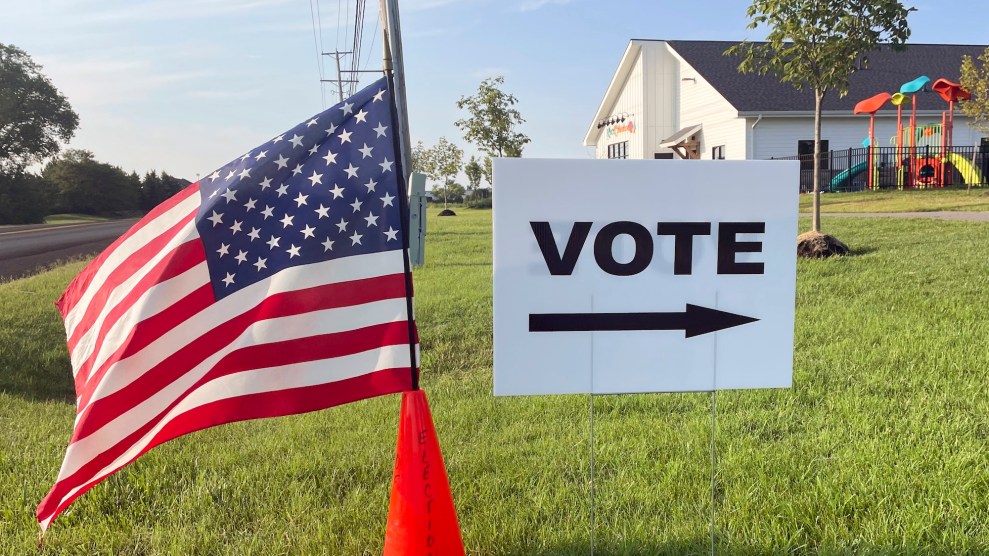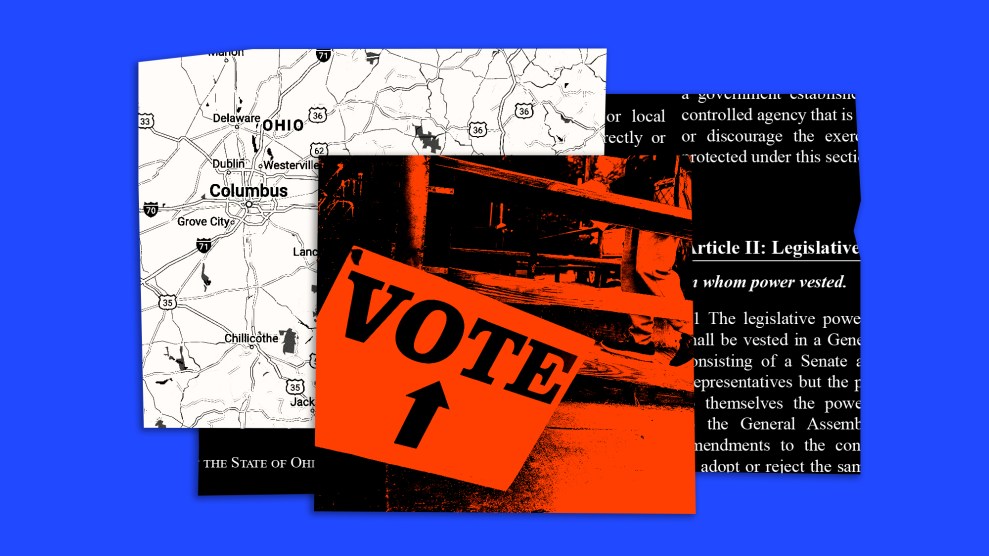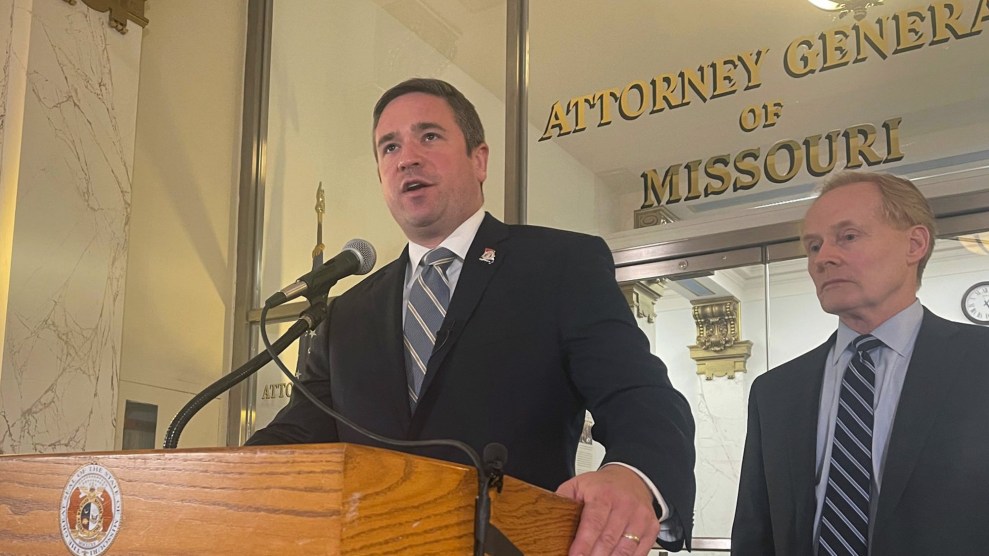
Samantha Hendrickson/AP
A Republican-driven effort to make it harder to amend the Ohio constitution failed in a special election on Tuesday. The defeated measure, known as Issue 1, would have effectively torpedoed the state’s direct democracy process, raising the vote threshold required to amend the state constitution from a simple majority to 60 percent, and requiring the supporters of would-be amendments to gather signatures from all 88 counties in Ohio, rather than half of them. With 37 percent of the vote counted when the Associated Press called the election, 61 percent of voters had rejected it.
On paper, the measure before voters on Tuesday had nothing to do with abortion. But in practice, Issue 1 was “100 percent” about abortion, to quote Republican Secretary of State Frank LaRose. That’s because, in just three months, Ohioans will vote on a referendum to guarantee the right to “reproductive freedom” in the state constitution—an effort currently projected to receive 50 to 60 percent approval from voters.
Such strong polling isn’t surprising, even in Ohio, where anti-abortion Republicans dominate the legislature and passed a 6-week abortion ban last year. (The ban is currently blocked by the courts; a judge ruled it would “completely eliminate the rights of Ohio women.”) Since the Supreme Court overturned Roe v. Wade last June, voters have chosen the pro-choice position in every single abortion-related referendum that’s appeared on a state ballot. This trend has held true not just in blue states like California and Vermont, but also in deep-red Kansas and Kentucky, where voters last year rejected proposals to put no-right-to-abortion clauses in their state constitutions. In Michigan, another midwestern battleground state, 57 percent of voters approved a ballot initiative with near-identical language to that on the table in Ohio.
Knowing this recent history, Republicans in the Ohio statehouse tried to change the rules before their constituents get a chance to vote for abortion rights. In May, they passed a resolution forcing a statewide vote on whether to make it harder to pass any future amendments. They claimed their effort, which was largely funded by far-right Illinois billionaire Richard Uihlein, was intended to block interference from “out-of-state special interests.” But they specifically made sure the vote on their proposal took place before the abortion-rights vote in November. To that end, they approved a bill this spring reinstating August special elections—most which they had just eliminated on the theory that summer elections were too low turnout to be worth the cost. (“These unnecessary ‘off-cycle’ elections aren’t good for taxpayers, election officials or the civic health of our state. It’s time for them to go!” LaRose, who is running for Senate, had previously argued.)
But this strategy backfired on Republicans on Tuesday. Huge numbers of people turned out to vote early on Issue 1, with nearly 700,000 early ballots cast. That’s more than double the early vote count for the state’s last contested primary, and almost five times the early vote in the last August special election. According to the Associated Press, the surge in early voting appeared driven by Democrats and women.
The trend continued on Tuesday, with turnout almost reaching 2022 levels in Democratic areas like the city of Cleveland.
Ohio voters not only turned out to protect abortion rights, but also to rebut the actions of the heavily gerrymandered GOP-controlled legislature, where Republicans hold 67 percent of seats in the state house and 79 percent in the state senate despite Trump winning the state with 53 percent of the vote. Issue 1 was viewed as yet another power grab by a legislature that has insulated itself from voters. “Blocking citizen access to the ballot would remove the last check on our corrupt and extremist legislature,” Mia Lewis, associate director of Common Cause Ohio, said before the vote.
The vote to safeguard direct democracy in Ohio builds on momentum from other recent victories. In 2022, voters defeated election-denying candidates for top offices in the six battleground states where Donald Trump tried to overturn the 2020 results. In April, Wisconsin voters overwhelmingly chose Judge Janet Protasiewicz to the Wisconsin Supreme Court in an election that was defined by concern over abortion rights and GOP efforts to undermine democracy, such as gerrymandering and voter suppression.
The defeat of Issue 1 now clears the way for voters to support abortion rights in November. The proposed amendment, which will go to voters on November 7, would guarantee individuals the right to “make and carry out one’s own reproductive decisions, including but not limited to decisions on contraception, fertility treatment, continuing one’s own pregnancy, miscarriage care, and abortion.” The measure includes language designed to stop the state from over-regulating abortion clinics. Yet it does allow the legislature to ban abortion after the point of fetal viability, unless a doctor deems it necessary to protect a pregnant patient’s health.
The Ohio vote could have major ramifications for other states. As many as eight states could vote on abortion-rights ballot initiatives in 2024, according to Chris Melody Fields Figueredo, executive director of the left-leaning Ballot Initiative Strategy Center. Such measures have so far been filed in Maryland, South Dakota, and Missouri, where Republican leaders have been pulling their own stunts to block the referendum process. And an abortion-rights referendum very similar to those in Ohio and Michigan has been filed in Florida, which in 2006 became the first and only state in the country to require 60 percent of the vote to pass a constitutional amendment.
“Republicans should be ashamed of their efforts to subvert the will of voters,” NARAL Pro-Choice America said in a statement on Tuesday night. “Seeing this measure defeated is a victory for our fundamental rights and our democracy.”















